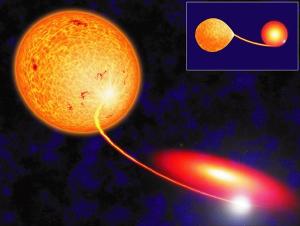Blog
Superhump
14 November 2013
 New Mexico State University
New Mexico State UniversityWhat’s a superhump? And what has it got to do with astronomy?
It all has to do with binary stars. Specifically a binary system where one of the stars (usually a white dwarf) is capturing material from the other, as depicted in the image above. These binary systems are often called cataclysmic variables, or cataclysmic binaries, because the light and energy they give off can vary significantly.
As the white dwarf captures material from its companion, the material forms an accretion disk around the white dwarf. Occasionally a hotspot can form in the accretion disk, and this causes a gradual variation in the brightness of the binary known as a hump. As the pair orbits, the accretion disk (and the hot spot) becomes blocked by the companion, and then visible again from our vantage point, thus the “hump” in brightness.
Sometimes the accretion disk can have an even bigger hotspot known as an outburst. In some of these outbursts the accretion disk can become unstable and basically rip apart. Again there is a variation in brightness, but the variation is much larger, and is called a superhump. What’s interesting about superhumps is that the variation is almost (but not quite) equal to the orbital period of the binary system. If the brightness variation was simply due to the (now ripped apart) accretion disk moving in front of and behind the companion star, you would think the superhump would follow the orbital period. But since it is a bit off, what gives?
A recent paper in Acta Astronomica looks at this issue.1 The working model first proposed in the 1990s was that the difference is due to tidal effects. Basically a resonance would build between the accretion disk and companion star causing the accretion disk to shift over time (apisidal precession). During an outburst this causes a bulge in the accretion material that leads to the variation in brightness.
But this alone can’t account for the brightness of the superhumps, as the paper points out. It seems there is also an interaction between the accretion of new material and the outburst of the accretion disk. As the bulge forms in the accretion disk, this affects the influx of new material, and the combined effects lead to the variation in brightness we see from the system.
It is clear there are some complex interactions happening under a rather silly name.
Smak, J. “On the Nature of Superhumps.” arXiv preprint arXiv:1307.1228 (2013). ↩︎